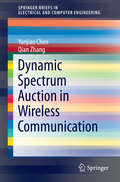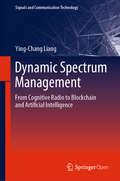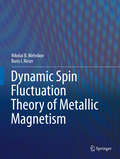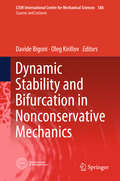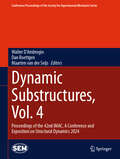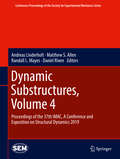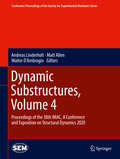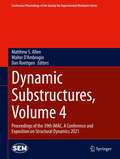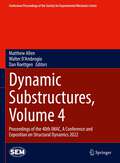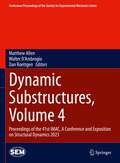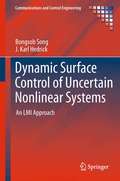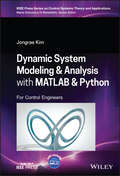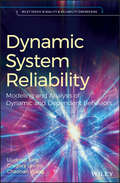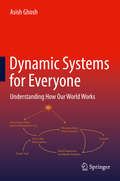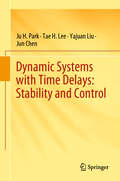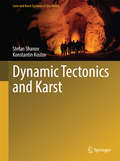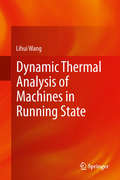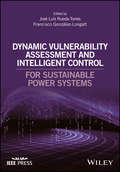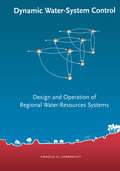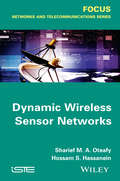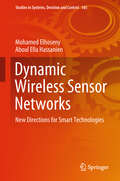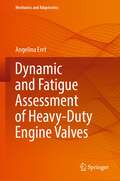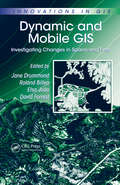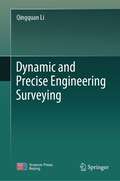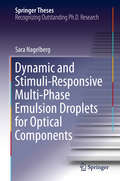- Table View
- List View
Dynamic Spectrum Auction in Wireless Communication
by Yanjiao Chen Qian ZhangThis brief explores current research on dynamic spectrum auctions, focusing on fundamental auction theory, characteristics of the spectrum market, spectrum auction architecture and possible auction mechanisms. The brief explains how dynamic spectrum auctions, which enable new users to gain spectrum access and existing spectrum owners to obtain financial benefits, can greatly improve spectrum efficiency by resolving the artificial spectrum shortage. It examines why operators and users face significant challenges due to specialty of the spectrum market and the related requirements imposed on the auction mechanism design. Concise and up-to-date, Dynamic Spectrum Auction in Wireless Communication is designed for researchers and professionals in computer science or electrical engineering. Students studying networking will also find this brief a valuable resource.
Dynamic Spectrum Management: From Cognitive Radio to Blockchain and Artificial Intelligence (Signals and Communication Technology)
by Ying-Chang LiangThis open access book, authored by a world-leading researcher in this field, describes fundamentals of dynamic spectrum management, provides a systematic overview on the enabling technologies covering cognitive radio, blockchain, and artificial intelligence, and offers valuable guidance for designing advanced wireless communications systems. This book is intended for a broad range of readers, including students and professionals in this field, as well as radio spectrum policy makers.
Dynamic Spin-Fluctuation Theory of Metallic Magnetism
by Nikolai B. Melnikov Boris I. ReserThis book presents a theoretical framework for magnetism in ferromagnetic metals and alloys at finite temperatures. The objective of the book is twofold. First, it gives a detailed presentation of the dynamic spin-fluctuation theory that takes into account both local and long-wave spin fluctuations with any frequency. The authors provide a detailed explanation of the fundamental role of quantum spin fluctuations in the mechanism of metallic magnetism and illustrate the theory with concrete examples. The second objective of the book is to give an accurate and self-contained presentation of many-body techniques such as the functional integral method and Green's functions, via a number of worked examples. These computational methods are of great use to solid state physicists working in a range of specialties.The book is intended primarily for researchers, but can also be used as textbook. The introductory chapters offer clear and complete derivations of the fundamentals, which makes the presentation self-contained. The main text is followed by a number of well-organized appendices that contain a detailed presentation of the necessary many-body techniques and computational methods. The book also includes a list of symbols and detailed index. This volume will be of interest to a wide range of physicists interested in magnetism and solid state physics in general, both theoreticians and experimentalists.
Dynamic Stability and Bifurcation in Nonconservative Mechanics (CISM International Centre for Mechanical Sciences #586)
by Davide Bigoni Oleg KirillovThe book offers a unified view on classical results and recent advances in the dynamics of nonconservative systems. The theoretical fundamentals are presented systematically and include: Lagrangian and Hamiltonian formalism, non-holonomic constraints, Lyapunov stability theory, Krein theory of spectra of Hamiltonian systems and modes of negative and positive energy, anomalous Doppler effect, reversible systems, sensitivity analysis of non-self-adjoint operators, dissipation-induced instabilities, local and global instabilities. They are applied to engineering situations such as the coupled mode flutter of wings, flags and pipes, flutter in granular materials, piezoelectric mechanical metamaterials, wave dynamics of infinitely long structures, radiative damping, stability of high-speed trains, experimental realization of follower forces, soft-robot locomotion, wave energy converters, friction-induced instabilities, brake squeal, non-holonomic sailing, dynamics of moving continua, and stability of bicycles and walking robots. The book responds to a demand in the modern theory of nonconservative systems coming from the growing number of scientific and engineering disciplines including physics, fluid and solids mechanics, fluid-structure interactions, and modern multidisciplinary research areas such as biomechanics, micro- and nanomechanics, optomechanics, robotics, and material science. It is targeted at both young and experienced researchers and engineers working in fields associated with the dynamics of structures and materials. The book will help to get a comprehensive and systematic knowledge on the stability, bifurcations and dynamics of nonconservative systems and establish links between approaches and methods developed in different areas of mechanics and physics and modern applied mathematics.
Dynamic Substructures, Vol. 4: Proceedings of the 42nd IMAC, A Conference and Exposition on Structural Dynamics 2024 (Conference Proceedings of the Society for Experimental Mechanics Series)
by Walter D’Ambrogio Dan Roettgen Maarten van der SeijsDynamics of Coupled Structures, Volume 4: Proceedings of the 42nd IMAC, A Conference and Exposition on Structural Dynamics, 2024, the fourth volume of ten from the Conference brings together contributions to this important area of research and engineering. The collection presents early findings and case studies on fundamental and applied aspects of the Dynamics of Coupled Structures, including papers on: Linear Joints, Nonlinear Joints and Coupling Modal and Frequency Based Substructuring Round Robin Test Bed on Dynamic Substructuring Transfer Path Analysis and Force Estimation Interface Dynamics
Dynamic Substructures, Volume 4: Proceedings of the 37th IMAC, A Conference and Exposition on Structural Dynamics 2019 (Conference Proceedings of the Society for Experimental Mechanics Series)
by Randall L. Mayes Daniel Rixen Matthew S. Allen Andreas LinderholtDynamics of Coupled Structures, Volume 4: Proceedings of the 37th IMAC, A Conference and Exposition on Structural Dynamics, 2019, the fourth volume of eight from the Conference brings together contributions to this important area of research and engineering. The collection presents early findings and case studies on fundamental and applied aspects of the Dynamics of Coupled Structures, including papers on: Methods for Dynamic Substructures Applications for Dynamic SubstructuresInterfaces & SubstructuringFrequency Based Substructuring Transfer Path Analysis
Dynamic Substructures, Volume 4: Proceedings of the 38th IMAC, A Conference and Exposition on Structural Dynamics 2020 (Conference Proceedings of the Society for Experimental Mechanics Series)
by Matt Allen Andreas Linderholt Walter D’AmbrogioDynamics of Coupled Structures, Volume 4: Proceedings of the 38th IMAC, A Conference and Exposition on Structural Dynamics, 2020, the fourth volume of eight from the Conference brings together contributions to this important area of research and engineering. The collection presents early findings and case studies on fundamental and applied aspects of the Dynamics of Coupled Structures, including papers on:Methods for Dynamic Substructures Applications for Dynamic SubstructuresInterfaces & SubstructuringFrequency Based Substructuring Transfer Path Analysis
Dynamic Substructures, Volume 4: Proceedings of the 39th IMAC, A Conference and Exposition on Structural Dynamics 2021 (Conference Proceedings of the Society for Experimental Mechanics Series)
by Matthew S. Allen Walter D’Ambrogio Dan RoettgenDynamic Substructures, Volume 4: Proceedings of the 39th IMAC, A Conference and Exposition on Structural Dynamics, 2021, the fourth volume of nine from the Conference brings together contributions to this important area of research and engineering. The collection presents early findings and case studies on fundamental and applied aspects of the Dynamics of Coupled Structures, including papers on:Methods for Dynamic Substructures Applications for Dynamic SubstructuresInterfaces & SubstructuringFrequency Based Substructuring Transfer Path Analysis
Dynamic Substructures, Volume 4: Proceedings of the 40th IMAC, A Conference and Exposition on Structural Dynamics 2022 (Conference Proceedings of the Society for Experimental Mechanics Series)
by Matthew Allen Walter D’Ambrogio Dan RoettgenDynamics of Coupled Structures, Volume 4: Proceedings of the 40th IMAC, A Conference and Exposition on Structural Dynamics, 2022, the fourth volume of nine from the Conference brings together contributions to this important area of research and engineering. The collection presents early findings and case studies on fundamental and applied aspects of the Dynamics of Coupled Structures, including papers on:Transfer Path AnalysisBlocked Forces and Experimental TechniquesReal-Time Hybrid Substructuring and Uncertainty Quantification in SubstructuringNonlinear Substructuring
Dynamic Substructures, Volume 4: Proceedings of the 41st IMAC, A Conference and Exposition on Structural Dynamics 2023 (Conference Proceedings of the Society for Experimental Mechanics Series)
by Matthew Allen Walter D’Ambrogio Dan RoettgenDynamics of Coupled Structures, Volume 4: Proceedings of the 41st IMAC, A Conference and Exposition on Structural Dynamics, 2023, the fourth volume of ten from the Conference brings together contributions to this important area of research and engineering. The collection presents early findings and case studies on fundamental and applied aspects of the Dynamics of Coupled Structures, including papers on: Real-Time/Hybrid Substructuring Transfer Path Analysis Frequency Based Substructuring The Substructuring Benchmark Challenge New Challenges & Approaches in Substructuring
Dynamic Surface Control of Uncertain Nonlinear Systems
by Bongsob Song J. Karl HedrickAlthough the problem of nonlinear controller design is as old as that of linear controller design, the systematic design methods framed in response are more sparse. Given the range and complexity of nonlinear systems, effective new methods of control design are therefore of significant importance. Dynamic Surface Control of Uncertain Nonlinear Systems provides a theoretically rigorous and practical introduction to nonlinear control design. The convex optimization approach applied to good effect in linear systems is extended to the nonlinear case using the new dynamic surface control (DSC) algorithm developed by the authors. A variety of problems - DSC design, output feedback, input saturation and fault-tolerant control among them - are considered. The inclusion of applications material demonstrates the real significance of the DSC algorithm, which is robust and easy to use, for nonlinear systems with uncertainty in automotive and robotics. Written for the researcher and graduate student of nonlinear control theory, this book will provide the applied mathematician and engineer alike with a set of powerful tools for nonlinear control design. It will also be of interest to practitioners working with a mechatronic systems in aerospace, manufacturing and automotive and robotics, milieux.
Dynamic System Modelling and Analysis with MATLAB and Python: For Control Engineers (IEEE Press Series on Control Systems Theory and Applications)
by Jongrae KimDynamic System Modeling & Analysis with MATLAB & Python A robust introduction to the advanced programming techniques and skills needed for control engineering In Dynamic System Modeling & Analysis with MATLAB & Python: For Control Engineers, accomplished control engineer Dr. Jongrae Kim delivers an insightful and concise introduction to the advanced programming skills required by control engineers. The book discusses dynamic systems used by satellites, aircraft, autonomous robots, and biomolecular networks. Throughout the text, MATLAB and Python are used to consider various dynamic modeling theories and examples. The author covers a range of control topics, including attitude dynamics, attitude kinematics, autonomous vehicles, systems biology, optimal estimation, robustness analysis, and stochastic system. An accompanying website includes a solutions manual as well as MATLAB and Python example code. Dynamic System Modeling & Analysis with MATLAB & Python: For Control Engineers provides readers with a sound starting point to learning programming in the engineering or biology domains. It also offers: A thorough introduction to attitude estimation and control, including attitude kinematics and sensors and extended Kalman filters for attitude estimation Practical discussions of autonomous vehicles mission planning, including unmanned aerial vehicle path planning and moving target tracking Comprehensive explorations of biological network modeling, including bio-molecular networks and stochastic modeling In-depth examinations of control algorithms using biomolecular networks, including implementation Dynamic System Modeling & Analysis with MATLAB & Python: For Control Engineers is an indispensable resource for advanced undergraduate and graduate students seeking practical programming instruction for dynamic system modeling and analysis using control theory.
Dynamic System Reliability: Modeling and Analysis of Dynamic and Dependent Behaviors (Quality and Reliability Engineering Series)
by Liudong Xing Gregory Levitin Chaonan WangOffers timely and comprehensive coverage of dynamic system reliability theory This book focuses on hot issues of dynamic system reliability, systematically introducing the reliability modeling and analysis methods for systems with imperfect fault coverage, systems with function dependence, systems subject to deterministic or probabilistic common-cause failures, systems subject to deterministic or probabilistic competing failures, and dynamic standby sparing systems. It presents recent developments of such extensions involving reliability modelling theory, reliability evaluation methods, and features numerous case studies based on real-world examples. The presented dynamic reliability theory can enable a more accurate representation of actual complex system behavior, thus more effectively guiding the reliable design of real-world critical systems. Dynamic System Reliability: Modelling and Analysis of Dynamic and Dependent Behaviors begins by describing the evolution from the traditional static reliability theory to the dynamic system reliability theory, and provides a detailed investigation of dynamic and dependent behaviors in subsequent chapters. Although written for those with a background in basic probability theory and stochastic processes, the book includes a chapter reviewing the fundamentals that readers need to know in order to understand contents of other chapters which cover advanced topics in reliability theory and case studies. The first book systematically focusing on dynamic system reliability modelling and analysis theory Provides a comprehensive treatment on imperfect fault coverage (single-level/multi-level or modular), function dependence, common cause failures (deterministic and probabilistic), competing failures (deterministic and probabilistic), and dynamic standby sparing Includes abundant illustrative examples and case studies based on real-world systems Covers recent advances in combinatorial models and algorithms for dynamic system reliability analysis Offers a rich set of references, providing helpful resources for readers to pursue further research and study of the topics Dynamic System Reliability: Modelling and Analysis of Dynamic and Dependent Behaviors is an excellent book for undergraduate and graduate students, and engineers and researchers in reliability and related disciplines.
Dynamic Systems for Everyone: Understanding How Our World Works
by Asish GhoshSystems are everywhere and we are surrounded by them. We are a complex amalgam of systems that enable us to interact with an endless array of external systems in our daily lives. They are electrical, mechanical, social, biological, and many other types that control our environment and our well-being. By appreciating how these systems function, will broaden our understanding of how our world works. Readers from a variety of disciplines will benefit from the knowledge of system behavior they will gain from this book and will be able to apply those principles in various contexts. The treatment of the subject is non-mathematical, and the book considers some of the latest concepts in the systems discipline, such as agent based systems, optimization, and discrete events and procedures. The diverse range of examples provided in this book, will allow readers to:Apply system knowledge at work and in daily life without deep mathematical knowledge;Build models and simulate system behaviors on a personal computer; Optimize systems in many different ways;Reduce or eliminate unintended consequences;Develop a holistic world view .This book will enable readers to not only better interact with the systems in their professional and daily lives, but also allow them to develop and evaluate them for their effectiveness in achieving their designed purpose.Comments from Reviewers: “This is a marvelously well written introduction to Systems Thinking and System Dynamics - I like it because it introduces Systems Thinking with meaningful examples, which everyone should be able to readily connect” - Gene Bellinger, Organizational theorist, systems thinker, and consultant, Director Systems Thinking World “Excellent book ...very well written. Mr. Ghosh's world view of system thinking is truly unique” - Peter A. Rizzi, Professor Emeritus, University of Massachusetts Dartmouth “A thorough reading of the book provides an interesting way to view many problems in our society” –Bradford T. Stokes, Poppleton Chair and Professor Emeritus, The Ohio State University College of Medicine “This is a very good and very readable book that is a must read for any person involved in systems theory in any way - which may actually include just about everyone” - Peter G. Martin, Vice President Business Value Consulting, Schneider Electric
Dynamic Systems with Time Delays: Stability And Control
by Jun Chen Ju H. Park Tae H. Lee Yajuan LiuThis book presents up-to-date research developments and novel methodologies to solve various stability and control problems of dynamic systems with time delays. First, it provides the new introduction of integral and summation inequalities for stability analysis of nominal time-delay systems in continuous and discrete time domain, and presents corresponding stability conditions for the nominal system and an applicable nonlinear system. Next, it investigates several control problems for dynamic systems with delays including H(infinity) control problemEvent-triggered control problems; Dynamic output feedback control problems; Reliable sampled-data control problems. Finally, some application topics covering filtering, state estimation, and synchronization are considered. The book will be a valuable resource and guide for graduate students, scientists, and engineers in the system sciences and control communities.
Dynamic Tectonics and Karst
by Stefan Shanov Konstantin KostovThe karstic caves are favorable sites for tectonic events detecting, representing a conservative medium of three-dimensional framework where the tectonic deformations are well preserved. They also provide an environment conducive to dating and determining the geometrical parameters of past seismotectonic events. During the last three decades the study of dynamic tectonics and recent geodynamics in karst terrains has been subject of numerous publications, but it has not been systematically approached in a comprehensive monograph. This book collects the current state of knowledge on the relationship between karst and dynamic tectonics and presents a new methodology to its study. It puts forward several approaches for studying of recent geodynamics in karst terrains, such as tectonic stress fields reconstructions using structural analysis of the fracturing, geophysical studies of the rock anisotropy and fault-plane solutions from earthquakes, analysis of the spatial orientation and absolute dating of deformed speleothems, instrumental and mechanical measurements, monitoring and modeling - all supported with case studies from several karst areas worldwide, e. g. in Albania, Bulgaria, Cuba and France.
Dynamic Thermal Analysis of Machines in Running State
by Lihui WangWith the increasing complexity and dynamism in today's machine design and development, more precise, robust and practical approaches and systems are needed to support machine design. Existing design methods treat the targeted machine as stationery. Analysis and simulation are mostly performed at the component level. Although there are some computer-aided engineering tools capable of motion analysis and vibration simulation etc., the machine itself is in the dry-run state. For effective machine design, understanding its thermal behaviours is crucial in achieving the desired performance in real situation. Dynamic Thermal Analysis of Machines in Running State presents a set of innovative solutions to dynamic thermal analysis of machines when they are put under actual working conditions. The objective is to better understand the thermal behaviours of a machine in real situation while at the design stage. The book has two major sections, with the first section presenting a broad-based review of the key areas of research in dynamic thermal analysis and simulation, and the second section presents an in-depth treatment of relevant methodology and algorithms, leading to better understanding of a machine in real situation. The book is a collection of novel ideas, taking into account the need for presenting intellectual challenges while appealing to a broad readership, including academic researchers, practicing engineers and managers, and graduate students. Given the essential role of modern machines in factory automation and quality assurance, a book dedicated to the topic of dynamic thermal analysis, and its practical applications to machine design would be beneficial to readers of all design and manufacturing sectors, from machine design to automotive engineering, in better understanding the present challenges and solutions, as well as future research directions in this important area.
Dynamic Vulnerability Assessment and Intelligent Control: For Sustainable Power Systems
by José Luis Rueda-Torres Francisco González-LongattIdentifying, assessing, and mitigating electric power grid vulnerabilities is a growing focus in short-term operational planning of power systems. Through illustrated application, this important guide surveys state-of-the-art methodologies for the assessment and enhancement of power system security in short term operational planning and real-time operation. The methodologies employ advanced methods from probabilistic theory, data mining, artificial intelligence, and optimization, to provide knowledge-based support for monitoring, control (preventive and corrective), and decision making tasks. Key features: Introduces behavioural recognition in wide-area monitoring and security constrained optimal power flow for intelligent control and protection and optimal grid management. Provides in-depth understanding of risk-based reliability and security assessment, dynamic vulnerability assessment methods, supported by the underpinning mathematics. Develops expertise in mitigation techniques using intelligent protection and control, controlled islanding, model predictive control, multi-agent and distributed control systems Illustrates implementation in smart grid and self-healing applications with examples and real-world experience from the WAMPAC (Wide Area Monitoring Protection and Control) scheme. Supplementary material, including Matlab codes, available through the companion website: www.wiley.com/go/rueda_torres/dynamic Dynamic Vulnerability Assessment and Intelligent Control for Power Systems is a valuable reference for postgraduate students and researchers in power system stability as well as practicing engineers working in power system dynamics, control, and network operation and planning.
Dynamic Water-System Control
by A.H. LobbrechtTypically a large number of interests with conflicting requirements are involved in the management of a water system. The computer-based method of management introduced in this text - dynamic control - is designed to determine the most effective operational strategy.
Dynamic Wireless Sensor Networks (Focus Ser.)
by Hossam S. Hassanein Sharief M. OteafyIn this title, the authors leap into a novel paradigm of scalability and cost-effectiveness, on the basis of resource reuse. In a world with much abundance of wirelessly accessible devices, WSN deployments should capitalize on the resources already available in the region of deployment, and only augment it with the components required to meet new application requirements. However, if the required resources already exist in that region, WSN deployment converges to an assignment and scheduling scheme to accommodate for the new application given the existing resources. Such resources are polled from many fields, including multiple WSNs already in the field, static networks (WiFi, WiMAX, cellular, etc) in addition to municipal, industrial and mobile resources.The architecture, framework and pricing policy, as well as approaches for backward compatibility with existing deployments, are presented in this book. We elaborate on the formalization of the problem, and contrast with existing work on coverage. This paradigm adopts optimal assignments in WSNs and exploits dynamic re-programming for boosting post-deployment and backward compatible protocols.
Dynamic Wireless Sensor Networks: New Directions For Smart Technologies (Studies in Systems, Decision and Control #165)
by Aboul Ella Hassanien Mohamed ElhosenyThis book provides a collection of high-quality research works that address broad challenges in both theoretical and applied aspects of dynamic wireless sensor networks (WSNs) for intelligent and smart applications in a variety of environments. It presents the most central concepts associated with Dynamic Wireless Sensor Networks applications, and discusses issues surrounding Wireless Sensor Network Structures for complex and mobile-based applications. The book subsequently discusses several topics related to energy management in dynamic WSNs, and reviews the steps involved in building a secure and trusted data transmission model using the WSN applications of intelligent environments. Lastly, it discusses the applications of WSNs in live data systems such as SCADA systems. Readers will discover a collection of high-quality research works that address broad challenges in both theoretical and applied aspects of WSNs for intelligent real-life applications. In addition, the book presents original research on the application of a dynamic WSN to solve the problem of energy consumption in a secure WSN during the process of data aggregation and transmission. Written by respected experts in the field, the book will stimulate further efforts in the application of the intelligent WSNs model, helping to solve the problem of data processing in a limited resource WSN-based environment.
Dynamic and Fatigue Assessment of Heavy-Duty Engine Valves (Mechanics and Adaptronics)
by Angelina EretThis book provides findings on the simulation of the valve dynamic to the current technological standards. Above all, it delivers a simulation based and predictive approach on the fatigue strength assessment of four-stroke heavy-duty engine valves. The demand for more efficient combustion engines with fuel flexibility goes along with increasing component requirements regarding strength and durability, while the development costs should remain low. In this context, the present book focuses on the gas exchange valves of heavy-duty engines. Especially, the valves on the exhaust side have an increased risk of fatigue failure. The aim of this book is the generation of a predictive fatigue strength assessment to strengthen the frontloading of the exhaust valve design process and to increase the reliability of the component. In the context of fatigue assessment, this book examines the loads of the exhaust valve during its working cycle. Beside the high temperature and cylinder pressure, further loads act on the exhaust valve like actuation force or an eccentric impact of the valve on the valve seat ring. Furthermore, a bold valve secondary dynamic in the form of valve bending vibrations is observed on the exhaust valves of heavy-duty engines increasing the valve load even more. The cause of this secondary dynamic is unknown. This book investigates the valve loads to get the necessary input for the fatigue strength assessment. With respect to a predictive approach, the determination of valve dynamic and valve loads is based on a multibody simulation model of the valve train. In order to deliver predictive results and a transferable method, this simulation model includes all relevant physical effects to describe the valve dynamic accurately during all valve load phases of the working cycle. With the simulation model, the root cause for the bold valve secondary dynamic is examined iteratively. The model delivers not only the cause for the valve secondary dynamic but most importantly the critical valve loads. These loads deliver the input for the fatigue strength assessment. To ensure the robustness of the load data determined by the simulation model, the sensitivity of influences on the valve load is examined. In this context geometrical misalignment, fluctuations in load data and variable engine operation points are considered. A load collective based on the variation of influences on the valve load is the result of this analysis. All the results of the influence and sensitivity study are generated with the newly developed simulation model of the valve train. Moreover, this book outlines measurements on a testbed engine. In scope of these measurements are temperature and strain measurements of the valve. The generated data validate the simulation model of the valve train. Additionally, the statistical evaluation of the data is used in the subsequent fatigue strength assessment to increase the reliability of the results.
Dynamic and Mobile GIS: Investigating Changes in Space and Time (Innovations in GIS)
by David Forrest Elsa Joao Roland Billen Jane DrummondWith the widespread use of PDAs, wireless internet, Internet-based GIS, and 3G and 4G telecommunications, the technology supporting mobile GIS is rapidly gaining popularity and effectiveness. Dynamic and Mobile GIS: Investigating Changes in Space and Time addresses Web GIS, mobile GIS, and the modeling, processing, and representation of dynamic eve
Dynamic and Precise Engineering Surveying
by Qingquan LiDriven by the increasingly expanding needs of infrastructure construction, operation and maintenance, as well as the rapid developments of intelligent sensing and information technology, precise engineering surveying has been transformed from static, discrete, and manual into dynamic, continuous, and intelligent ways. This transformation leads to an advanced multidisciplinary field, dynamic and precise engineering surveying, on which the author has worked for over two decades. This book systematically summarizes the fundamentals, methods, and applications in dynamic and precise engineering surveying. The contents mainly include two parts: the first part introduces principles and methods of dynamic and precise engineering surveying; the second part presents representative applications in which innovative methods and advanced equipment are applied in the construction, operation and maintenance of mega and complex infrastructures.Readers engaged in surveying and mapping, civil engineering, water conservancy engineering, railway engineering, electronic information, and computer science, including undergraduates, graduates, researchers and engineers, will find it an informative reference.
Dynamic and Stimuli-Responsive Multi-Phase Emulsion Droplets for Optical Components (Springer Theses)
by Sara NagelbergThis thesis builds on recent innovations in multi-phase emulsion droplet design to demonstrate that emulsion morphologies enable a useful variety of dynamic optical phenomena. Despite the highly dynamic nature of fluid morphologies and their utility for stimuli-responsive, dynamic optical materials and devices, fluid matter is underrepresented in optical technology. Using bi-phase emulsion droplets as refractive micro-optical components, this thesis realizes micro-scale fluid compound lenses with optical properties that vary in response to changes in chemical concentrations, structured illumination, and thermal gradients. Theoretical considerations of emulsions as optical components are used to explain a previously unrecognized total internal reflection-enabled light interference phenomenon in emulsion droplets that results in rich structural coloration. While this work is focused on the fundamental optics of emulsion droplets, it also facilitates the use of light-emitting emulsion morphologies as chemo-optical transducers for early-stage food-borne pathogen detection. This thesis beautifully demonstrates the virtue of fundamental interdisciplinary exploration of unconventional material systems at the interface of optics, chemistry, and materials science, and the benefits arising from translation of the acquired knowledge into specific application scenarios.
